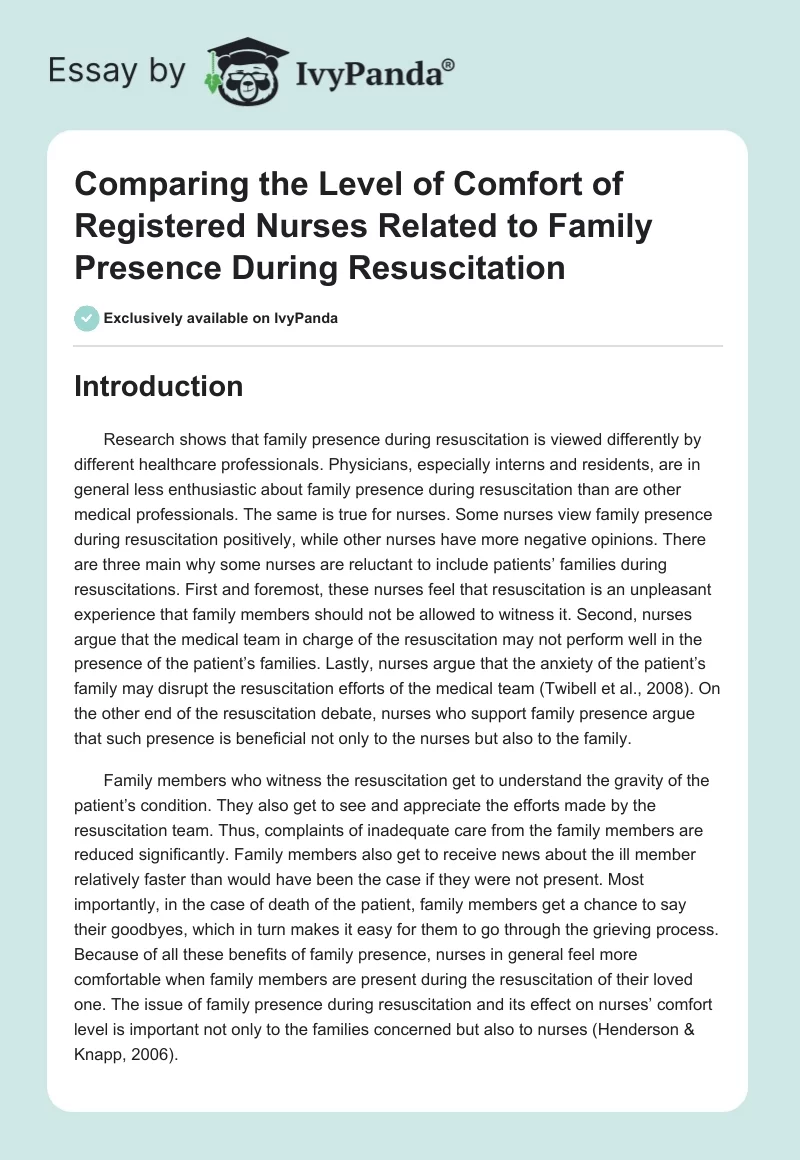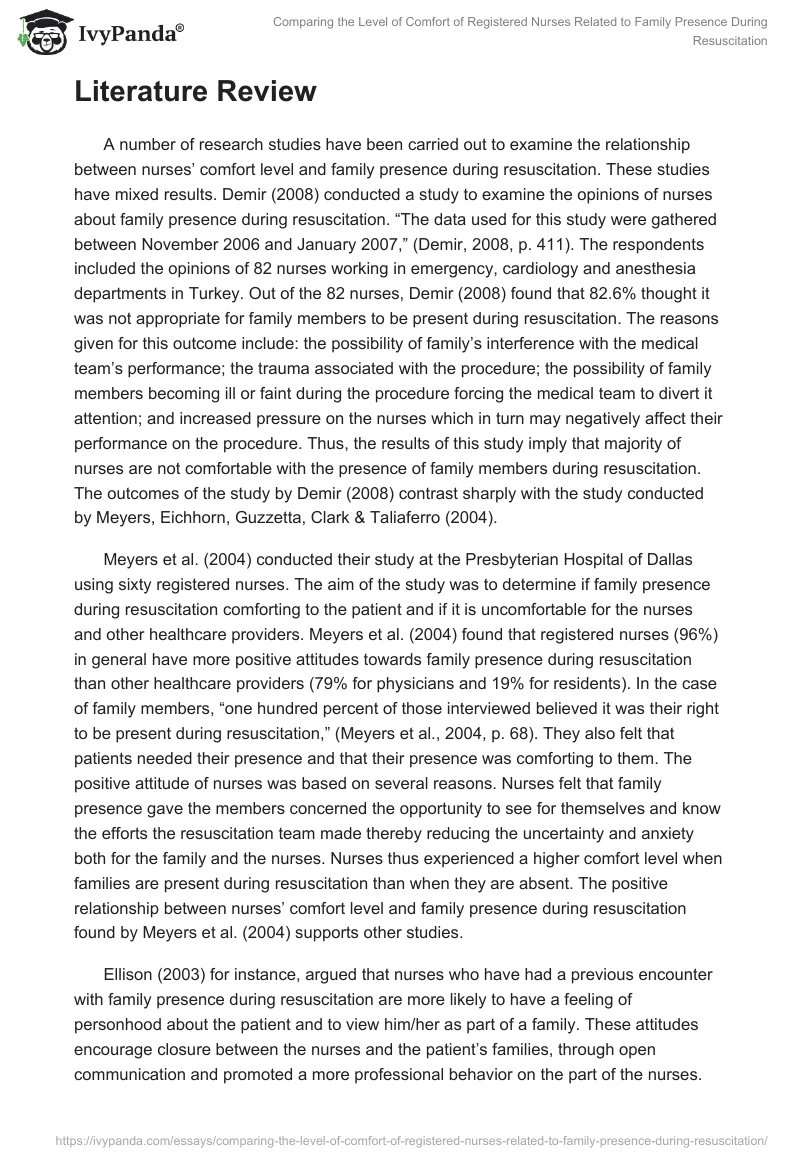Introduction
Research shows that family presence during resuscitation is viewed differently by different healthcare professionals. Physicians, especially interns and residents, are in general less enthusiastic about family presence during resuscitation than are other medical professionals. The same is true for nurses. Some nurses view family presence during resuscitation positively, while other nurses have more negative opinions. There are three main why some nurses are reluctant to include patients’ families during resuscitations. First and foremost, these nurses feel that resuscitation is an unpleasant experience that family members should not be allowed to witness it. Second, nurses argue that the medical team in charge of the resuscitation may not perform well in the presence of the patient’s families. Lastly, nurses argue that the anxiety of the patient’s family may disrupt the resuscitation efforts of the medical team (Twibell et al., 2008). On the other end of the resuscitation debate, nurses who support family presence argue that such presence is beneficial not only to the nurses but also to the family.
Family members who witness the resuscitation get to understand the gravity of the patient’s condition. They also get to see and appreciate the efforts made by the resuscitation team. Thus, complaints of inadequate care from the family members are reduced significantly. Family members also get to receive news about the ill member relatively faster than would have been the case if they were not present. Most importantly, in the case of death of the patient, family members get a chance to say their goodbyes, which in turn makes it easy for them to go through the grieving process. Because of all these benefits of family presence, nurses in general feel more comfortable when family members are present during the resuscitation of their loved one. The issue of family presence during resuscitation and its effect on nurses’ comfort level is important not only to the families concerned but also to nurses (Henderson & Knapp, 2006).
Literature Review
A number of research studies have been carried out to examine the relationship between nurses’ comfort level and family presence during resuscitation. These studies have mixed results. Demir (2008) conducted a study to examine the opinions of nurses about family presence during resuscitation. “The data used for this study were gathered between November 2006 and January 2007,” (Demir, 2008, p. 411). The respondents included the opinions of 82 nurses working in emergency, cardiology and anesthesia departments in Turkey. Out of the 82 nurses, Demir (2008) found that 82.6% thought it was not appropriate for family members to be present during resuscitation. The reasons given for this outcome include: the possibility of family’s interference with the medical team’s performance; the trauma associated with the procedure; the possibility of family members becoming ill or faint during the procedure forcing the medical team to divert it attention; and increased pressure on the nurses which in turn may negatively affect their performance on the procedure. Thus, the results of this study imply that majority of nurses are not comfortable with the presence of family members during resuscitation. The outcomes of the study by Demir (2008) contrast sharply with the study conducted by Meyers, Eichhorn, Guzzetta, Clark & Taliaferro (2004).
Meyers et al. (2004) conducted their study at the Presbyterian Hospital of Dallas using sixty registered nurses. The aim of the study was to determine if family presence during resuscitation comforting to the patient and if it is uncomfortable for the nurses and other healthcare providers. Meyers et al. (2004) found that registered nurses (96%) in general have more positive attitudes towards family presence during resuscitation than other healthcare providers (79% for physicians and 19% for residents). In the case of family members, “one hundred percent of those interviewed believed it was their right to be present during resuscitation,” (Meyers et al., 2004, p. 68). They also felt that patients needed their presence and that their presence was comforting to them. The positive attitude of nurses was based on several reasons. Nurses felt that family presence gave the members concerned the opportunity to see for themselves and know the efforts the resuscitation team made thereby reducing the uncertainty and anxiety both for the family and the nurses. Nurses thus experienced a higher comfort level when families are present during resuscitation than when they are absent. The positive relationship between nurses’ comfort level and family presence during resuscitation found by Meyers et al. (2004) supports other studies.
Ellison (2003) for instance, argued that nurses who have had a previous encounter with family presence during resuscitation are more likely to have a feeling of personhood about the patient and to view him/her as part of a family. These attitudes encourage closure between the nurses and the patient’s families, through open communication and promoted a more professional behavior on the part of the nurses. Nurses who support family presence also argue that family members may offer assistance during the procedure which in turn encouraged them to make rational end-of-life decisions. All these benefits enhance the comfort level of nurses during resuscitations.
On the same note Fisher et al. (2008) found that majority of the nurses in their study engaged in behaviors which supported family presence during resuscitation. These behaviors encompassed open communication with the family members, educating them, involving them in the procedures of care of the patient, and providing them with psychosocial support. These behaviors enhanced the relationship between the nurses and the family members which in turn increased the nurses’ comfort levels during the resuscitation procedure. This finding supports the study by Fulbrook, Albarran & Latour (2005) and MacLean et al. (2003) who argued that family presence during resuscitation is advantageous not only to the family members and the patient but also to the nurses and other healthcare providers involved.
Description of the Gap in Knowledge
The studies which have addressed the relationship between the level of nurses’ comfort and family presence during resuscitation are limited in several ways. The major limitation is the type and size of sample used in the studies. Almost all the studies have used nurses who are based in emergency and critical care departments. In addition, the size of nurses used in the studies is low with majority of the studies using a sample size of less than one hundred. Moreover, the participants used are drawn from one particular hospital and from one region (Twibell et al., 2008). Because of these limitations, it is difficult to tell if there would be different outcomes if a large sample size of registered nurses was used; if the participants were drawn from different hospitals; and if the participants were drawn from different regions. The hypothesis proposed in this study would help to narrow the knowledge gap of family presence during resuscitation by addressing these limitations.
Summary
The literature review has shown that family presence during resuscitation is indeed critical not only for the patient and his/her family but also for the nurses. Families present during the resuscitation feel that they are taking care of their loved one. In the case of death of the patient, family members are better able to handle the grieving process because they know that the patient received the best care and nothing more could have been done. In addition, family members feel that they had a chance to say goodbye to their loved one and are therefore able to heal faster. All these benefits experienced by family members spill over to nurses who are involved in the resuscitation procedure. All the studies reviewed above support this hypothesis save for the study conducted by Demir (2008) who found a negative association. The reason for this negative outcome could be because the study was conducted in Turkey and therefore cultural beliefs and differences may have affected the outcomes. It is therefore important for future studies to take into consideration the effect of ethnicity, a larger sample size, nurses from non-critical departments, and nurses from multiple hospitals, on the relationship between nurses’ comfort levels and family presence during resuscitation. All in all, the purpose of this study is to test the hypothesis that “the level of nurses’ comfort is higher if family members are present during resuscitation”.
Statement of Hypothesis
The level of nurses’ comfort is higher if family members are present during resuscitation.
Reference List
Demir, F. (2008). Presence of patients’ families during cardiopulmonary resuscitation: physicians’ and nurses’ opinions. Journal of Advanced Nursing, 63(4), 409-416.
Ellison, S. (2003). Nurses’ attitudes toward family presence during resuscitative efforts and invasive procedures. Journal of Emergency Nursing, 29(6), 587-594.
Fisher, C., Lindhorst, H., Matthews, T., Munroe, D., Paulin, D., & Scott, D. (2008). Nursing staff attitudes and behaviors regarding family presence in the hospital setting. Journal of Advanced Nursing, 64(6), 615-624.
Fulbrook, P., Albarran, J., & Latour, J. (2005). A European survey of critical care nurses’ attitudes and experiences of having family members present during cardiopulmonary resuscitation. International Journal of Nursing Studies, 42, 557-568.
Henderson, D., & Knapp, J. (2006). Report of the National Consensus Conference on Family Presence during Pediatric Resuscitation and Procedures. Journal of Emergency Nursing, 32, 23-29.
MacLean, S., Guzzetta, C., White, C., Fontaine, D., Eichhorn, D.J., Meyers, T., & Desy, P. (2003). Family presence during cardiopulmonary resuscitation and invasive procedures: Practices of critical care and emergency nurses. American Journal of Critical Care, 12, 246–256.
Meyers, T., Eichhorn, D., Guzzetta, C., Clark, A., & Taliaferro, E. (2004). Family presence during invasive procedures and resuscitation: The experience of family members, nurses, and physicians. Topics in Emergency Medicine, 26(1), 61-73.
Twibell, R., Siela, D, Riwitis, C., Wheatley, J., Riegle, T., Bousman, D., et al. (2008). Nurses’ perceptions of their self-confidence and the benefits and risks of family presence during resuscitation. American Journal f Critical Care, 17(2), 101-111.


